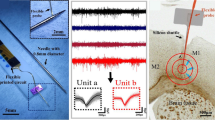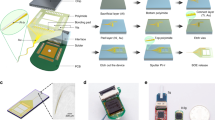Abstract
A flexible polyimide cable developed for implantable neural probe array application is presented. The flexible cable is used to connect two implantable platforms—one in direct touch with the brain containing a neural probe array and its interface IC, and the other on the skull including a wireless link IC, a coil and an antenna for power and data transfer through the transcutaneous link. The cable needs to be highly flexible to minimize post-insertion injury caused by the probe array in the presence of brain micro-motion. Polyimide is used to form a flexible substrate and an insulator layer of the cable. For the advanced neural recording system, a large amount of neural recording data has to be communicated between the two platforms through the flexible cable. High-rate data transmission performance of the fabricated flexible cable is characterized and discussed. The measured insertion loss (IL) of the flexible cable is less than 3 dB and the isolation between two adjacent interconnects is better than 17 dB up to 2 GHz. The data transmission through the flexible cable is verified to be highly reliable at 100 Mbps. For surgical manipulation and long term implantation of the neural probe microsystem, the flexible cable needs to have excellent mechanical strength and resistance to fatigue. The mechanical characteristics and fatigue strength of the flexible cable are also measured and discussed. The measured maximum tensile stress and strain of the flexible cable before failure are 251.2 ± 7.1 MPa (14.35 ± 0.3 N) and 4.16 ± 0.11 %, respectively. The Young’s modulus of the fabricated flexible cable is 8.21 GPa. From the fatigue strength testing, the measured resistance change of the flexible cable’s interconnect is less than 4.8 % after 250,000 cycles of cyclic mechanical stretch.












Similar content being viewed by others
References
Bai Q, Wise KD, Anderson DJ (2000) A high-yield microassembly structure for three-dimensional microelectrode arrays. IEEE Trans Bio Med Eng 47:281–289
Eisenstadt WR, Eo Y (1992) S-parameter-based IC interconnect transmission line characterization. IEEE Trans Compon Hybrids Manuf Technol 15:483–490
Goldstein SR, Salcman M (1973) Mechanical factors in design of chronic recording intracortical microelectrodes. IEEE Trans Bio Med Eng 20:260–269
Herwik S, Kisban S, Aarts AAA, Seidl K, Girardeau G, Benchenane K, Zugaro MB, Wiener SI, Paul O, Neves HP, Ruther P (2009) Fabrication technology for silicon-based microprobe arrays used in acute and sub-chronic neural recording. J Micromech Microeng 19:1–11
Hetke JF, Lund JL, Najafi K, Wise KD, Anderson DJ (1994) Silicon ribbon cables for chronically implantable microelectrode arrays. IEEE Trans Bio Med Eng 41:314–321
Hochberg LR, Serruya MD, Friehs GM, Mukand JA, Saleh M, Caplan AH, Branner A, Chen D, Penn RD, Donoghue JP (2006) Neuronal ensemble control of prosthetic devices by a human with tetraplegia. Nature 442:164–171
Lee YT, Lin CW, Lin CM, Yeh SR, Chang YC, Fang W (2010) A pseudo 3D glass microprobe array: glass microprobe with embedded silicon for alignment and electrical interconnection during assembly. J Micromech Microeng 20:1–9
Meyer JU, Stieglitz T, Scholz O, Haberer W, Beutel H (2001) High density interconnects and flexible hybrid assemblies for active biomedical implants. IEEE Trans Adv Packag 24:366–374
Norlin P, Kindlundh M, Mouroux A, Yoshida K, Hofmann UG (2002) A 32-site neural recording probe fabricated by DRIE of SOI substrates. J Micromech Microeng 12:414–419
Pang C, Cham JG, Nenadic Z, Musallam S, Tai SC, Burdick JW, Andersen RA (2005) A new multi-site probe array with monolithieally integrated parylene flexible cable for neural prostheses. In: Prof of Intl Conf IEEE Eng Med and Bio, Shanghai, China, pp 7114–7117
Rousche PJ, Pellinen DS, Pivin DP, Williams JC, Vetter RJ, Kipke DR (2001) Flexible polyimide-based intracortical electrode arrays with bioactive capability. IEEE Trans Bio Med Eng 48:361–371
Rubehn B, Stieglitz T (2010) In vitro evaluation of the long-term stability of polyimide as a material for neural implants. Biomaterials 31:3449–3458
Stieglitz T, Beutel HE, Schuettler M, Meyer JU (2000) Micromachined, polyimide-based devices for flexible neural interfaces. Biomed Microdevices 2:283–294
Takeuchi S, Suzuki T, Mabuchi K, Fujita H (2004) 3D flexible multichannel neural probe array. J Micromech Microeng 14:104–107
Velliste M, Perel S, Spalding MC, Whitford AS, Schwartz AB (2008) Cortical control of a prosthetic arm for self-feeding. Nature 453:1098–1101
Wise KD, Bhatti PT, Wang JB, Friedrich CR (2008) High-density cochlear implants with position sensing and control. Hearing Res 242:22–30
Yao Y, Gulari MN, Casey B, Wiler JA, Wise KD (2007) Silicon microelectrodes with flexible integrated cables for neural implant applications. In: Proc of EMBS Conf Neural Eng, Kohala Coast, pp 398–401
Acknowledgments
This work was supported by the Science and Engineering Research Council of Agency for Science, Technology andResearch, Singapore (A*STAR) under Grant 102 171 0160. The authors would like to thank Mr. Myo Paing and Ms. Chew Bi-Rong Michelle from Institute of Microelectronics (IME), Singapore, for their advice and help in fabrication and flip chip bonding of the silicon chip. We would also like to thank clean room staffs at the IME, who helped fabrication of the structures presented.
Author information
Authors and Affiliations
Corresponding author
Rights and permissions
About this article
Cite this article
Cheng, MY., Park, WT., Yu, A. et al. A flexible polyimide cable for implantable neural probe arrays. Microsyst Technol 19, 1111–1118 (2013). https://doi.org/10.1007/s00542-012-1707-6
Received:
Accepted:
Published:
Issue Date:
DOI: https://doi.org/10.1007/s00542-012-1707-6




